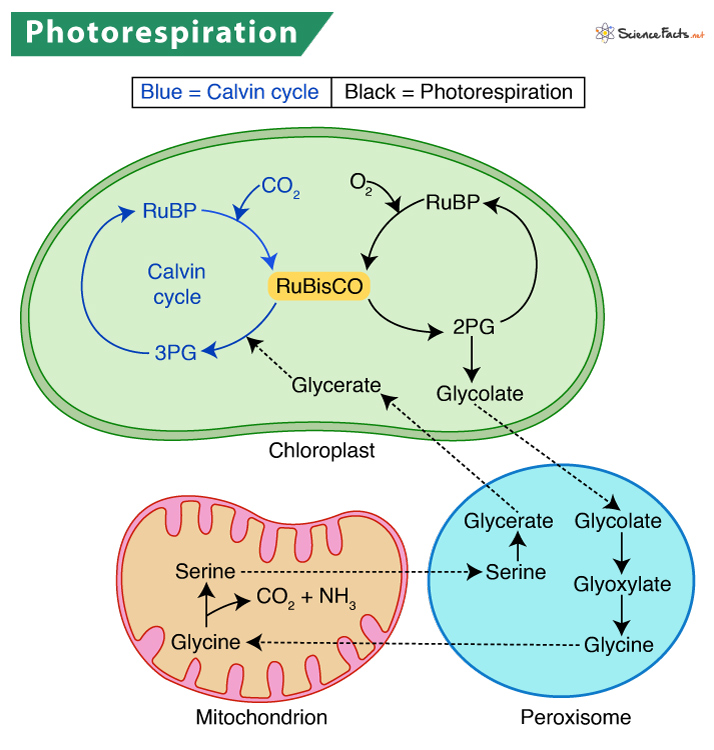Photorespiration, also known as oxidative photosynthetic carbon cycle or C2 photosynthesis, is a process found in normal C3 plant respiration. Here, the enzyme RuBisCO uses O2 as a substrate instead of CO2. This alternative pathway leads to the loss of fixed carbon, wastes energy, and decreases sugar synthesis.
Factors Affecting Photorespiration
Mechanism: What Happens During Photorespiration
Why Is Photorespiration Bad for Plants
Why Does Photorespiration Occur
Adaptations in Plants to Minimize Photorespiration
Photorespiration vs. Photosynthesis
Photorespiration vs. Dark Respiration
1. Temperature
Increasing temperature also increases oxygenation in two ways. RuBisCO losses affinity for CO2 as the temperature rises such that it performs oxygenation. The second possible way temperature affects oxygenation is by its effect on the relative solubilities of O2 and CO2. Both the gases must dissolve in the water of the leaf before they can react with RuBisCO. With the increase in temperature, the solubility of any gas in water decreases. There is comparably less O2 and CO2 dissolved in cells at a higher temperature. However, the solubility of O2 decreases less with temperature than CO2. Thus, as the temperature rises, the CO2 to O2 ratio in the cell decreases, which starts favoring the oxygenation of RuBisCO.
2. Moisture Content
As the moisture content in the surroundings decreases, plants close their stomata. Inside the leaf, O2 is produced by Photosystem II and starts to increase its concentration. At the same time, CO2 is consumed by carboxylation and thus decreases in concentration. Consequently, CO2 to O2 ratio inside the leaf decreases when stomata are closed, which promotes oxygenation of RuBisCO. Thus, hot and dry conditions stimulate RuBisCO to perform photorespiration in plants by increasing its affinity for O2.
3. Relative Concentrations of O2 and CO2
From the above two factors, it is evident that high O2 to CO2 concentration favors the oxygenation of RuBisCO. Photorespiration begins in the chloroplast of a C3 plant when RuBisCO uses O2 and RuBP as substrates instead of CO2 producing one molecule of 3PG and one molecule of 2-phosphoglycolate (2PG). The equation is given below: Equation: RuBP + O2 → 2-Phosphoglycolate (2PG) + 3-phosphoglycerate (3PG) + 2H+ The 2PG is inhibitory to the Calvin cycle enzymes and thus needs to be removed and recycled back to 3PG to prevent depletion of Calvin cycle intermediates. This recycling is complex and involves 3 different organelles – chloroplast, peroxisome, and mitochondria. Steps of Photorespiration Some of the CO2 released (4th step) in the mitochondria enters the chloroplast through the cytosol, where they have access to RuBisCO to participate in the Calvin cycle. The ammonia (as NH4+) concomitantly released with CO2 in the glycine decarboxylase reaction is then transported from the mitochondrion to the chloroplast, where it is assimilated using the enzyme glutamine synthetase. This re-assimilation of ammonium consumes both ATP and reduced ferredoxin. When glutamate serves as an amino donor in glycine synthesis, 2-oxoglutarate is regenerated. Glutamate and 2-oxoglutarate are rapidly exchanged between peroxisome and chloroplast to keep the pathway running. An alternative theory about why plants need photorespiration is that it has some benefits in plants. It shields plants from the harmful effects of very high internal oxygen concentrations or high-energy phosphate molecules like ATP. The high concentrations of these substances occur when plants perform photosynthesis at a higher rate than usual. It is assumed that photorespiration consumes those oxygen and ATP molecules to a level that does not harm the plants.
How Do C4 Plants Minimize Photorespiration
In C4-plants, the light-dependent reaction and the Calvin cycle are physically separated. While the light-dependent reaction occurs in the mesophyll cells (spongy tissue in the middle of the leaf), the Calvin cycle occurs in the bundle sheath cells (special cells around the leaf veins). The initial step of the light-dependent reaction involves the fixation of carbon as CO2 in the mesophyll cells to form a 4-carbon organic acid (oxaloacetate). This step is catalyzed by PEP carboxylase, a non-rubisco enzyme. Oxaloacetate is converted to malate, which is then transported to the bundle sheath cells. Inside the bundle sheath cells, malate breaks down by releasing a molecule of CO2. Finally, the CO2 is fixed by RuBisCO and made into sugar by the Calvin cycle, similar to C3 photosynthesis. This pathway requires ATP expenditure. However, since the mesophyll cells constantly pump CO2 into bundle sheath cells in the form of malate, there is always a high concentration of CO2 than O2 around RuBisCO, thus suppressing photorespiration.
How Do CAM Plants Minimize Photorespiration
Plants adapted to dry environments such as cacti and pineapples minimize photorespiration by this pathway. The name ‘CAM’ was derived from the family of plants – the Crassulaceae, in which scientists first discovered the pathway. Here, instead of physically separating the light-dependent reaction and the Calvin cycle, CAM plants separate the two processes on time. During the night, plants open their stomata, allowing CO2 to diffuse into the leaves. The CO2 is fixed into oxaloacetate by the enzyme PEP carboxylase and then to malate or another type of organic acid. The organic acid formed is stored inside vacuoles until the next day. During the daytime, the CAM plants do not open their stomata but perform photosynthesis. The organic acids are exported out of the vacuole. They are subsequently broken down to release CO2, entering the Calvin cycle pathway. This controlled release of CO2 maintains a high concentration of CO2 around RuBisCO, thus helping to suppress photorespiration. This pathway, similar to C4-plants, requires ATP at multiple steps and thus cannot work without energy. The key differences between the two processes are given below:
Similarities
Occurs in plants during the production of glucoseUses the enzyme RuBisCOOccurs within cellular organellesRequires enzymesUndergo light reaction
